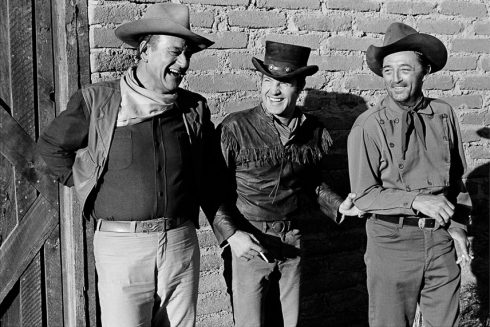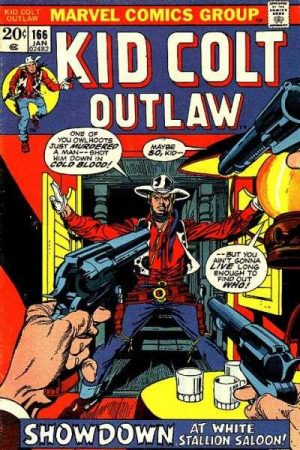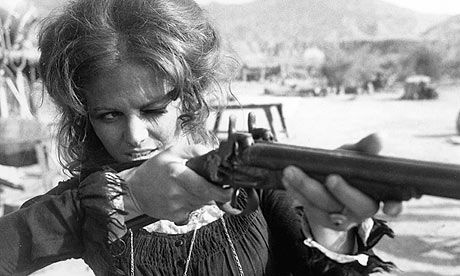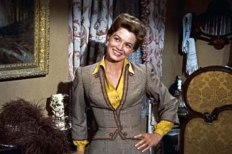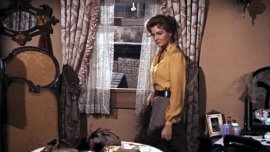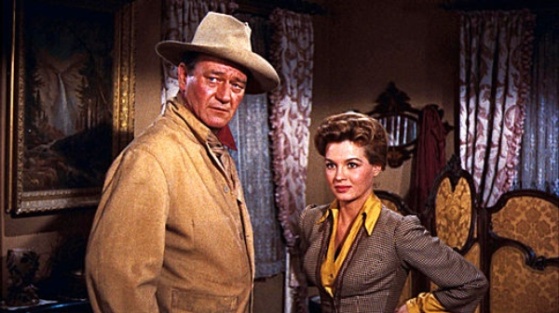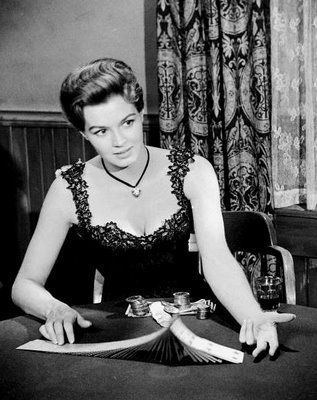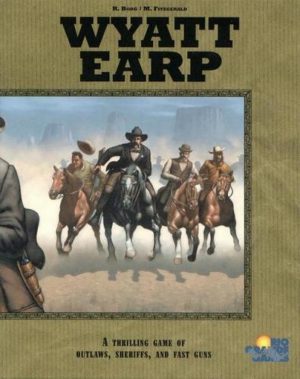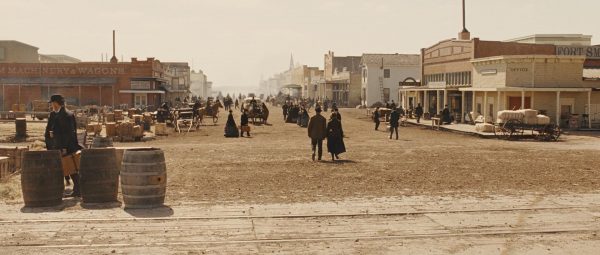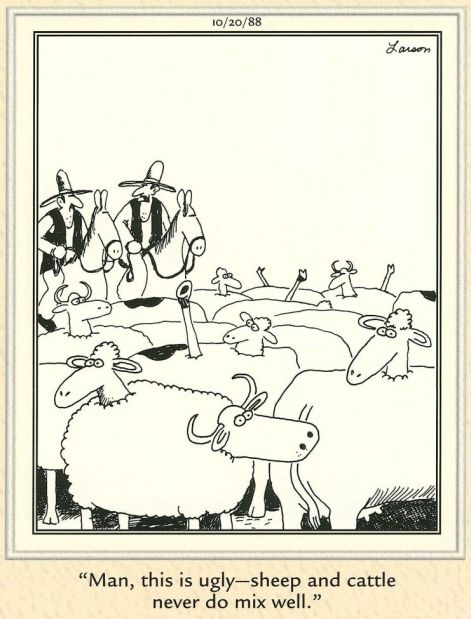
Monthly Archives: September 2018
Wanted: Dead or Alive (1958-1961)
Josh Randall was a hard man, sure; but he was never on the wrong side of morality. The show Wanted: Dead or Alive had some concerns that had to be addressed in order to be on the air, but thankfully they were handled and the world was treated to one of the best western shows to come out of the hey-day era. TV bigwigs didn’t think it would look good for the “hero” of the show to simply hunt other humans for a monetary reward. Therefore, it was decided that Randall would give his money, or a portion of it, over to someone whose path he had crossed in the course of his thirty-minute adventure that might have needed it a little more than him. If he hunted wanted men, but altruistically handed over a large portion to the local parson so he could feed some orphans whose parents had died in the latest Indian attack or disease outbreak, then our gunfighter could be more than just a protagonist, and honorably attain the legitimate title of hero.
And such it was in the world of Wanted. Every week Josh Randall was on the hunt and nearly always got his man. For anyone who may be unaware, Josh Randall was played by THE Steve McQueen. His performance was appropriately stoic and serious. He didn’t care about friendships or relationships, darn it, he had a job to do! He was never too wooden, but always played the role just right; jaded as necessary, and affable as needed.
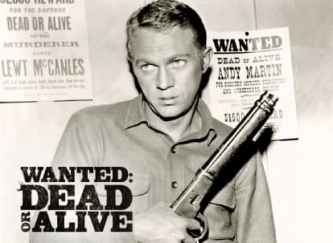 But it wasn’t just McQueen’s swagger, or his good looks as a gunman that made the show popular; there was a lot of credit due the ultra-cool rifle he had slapped against his leg. It was a Winchester Model 82 with a shortened barrel and stock called a Mare’s Leg. The lever was also oversized to a large oval, which increased the style factor when he needed to make a lifesaving defense against a desperate mark.
But it wasn’t just McQueen’s swagger, or his good looks as a gunman that made the show popular; there was a lot of credit due the ultra-cool rifle he had slapped against his leg. It was a Winchester Model 82 with a shortened barrel and stock called a Mare’s Leg. The lever was also oversized to a large oval, which increased the style factor when he needed to make a lifesaving defense against a desperate mark.
The show ran for three season, totaling 96 episodes, during which he found time to be featured in the now-classic Magnificent 7 (1960). Within a year of the movie’s release Wanted was done and McQueen was on to his movie career (He later played western gunman Tom Horn in a 1980 movie release).
This is definitely one of the best western TV shows and, amazingly, can be bought complete on DVD for very little. It’s recommended to get it if you enjoy westerns and don’t have it.
Here’s some fun facts for those interested…
- Josh Randall appeared in the Trackdown previous to Wanted: Dead or Alive. This served as a pilot for the new show, and was also where the gun was termed a Mare’s Leg.
- In 1987, Rutger Hauer starred in a film of the same name (colon punctuation included). The movie takes place in present day, but the main character is Nick Randall, a descendant of McQueen’s Josh Randall. He even has the ol’ family Mare’s Leg on display in his office
Kid Colt Outlaw
Blazing Adventures of the Wild West!
 Could a six-foot, blonde-haired, country boy named Blaine Colt come from anywhere other than the state Wyoming? Of course not! And so, appropriately enough, that’s just where Kid Colt came from, the town of Abilene Wyoming (it’s fictional, no need to look it up). Kid Colt was probably the earliest of the comic-book cowboys to make it in to the later days of the revisionist era, and although he took a slight back seat to Rawhide Kid in popularity, he really was the center piece for comic-book gunfighters.
Could a six-foot, blonde-haired, country boy named Blaine Colt come from anywhere other than the state Wyoming? Of course not! And so, appropriately enough, that’s just where Kid Colt came from, the town of Abilene Wyoming (it’s fictional, no need to look it up). Kid Colt was probably the earliest of the comic-book cowboys to make it in to the later days of the revisionist era, and although he took a slight back seat to Rawhide Kid in popularity, he really was the center piece for comic-book gunfighters.
Initially unwilling to use a gun, his father was murdered, and so Blaine gave up his idealistic stance and avenged his pa. This turned him into an outlaw and began his life on the run throughout the western frontier. Or at least that’s one version, and probably the most common. Owing to a print run that goes back to the 40’s several different publishing houses, there have been some variations on the Kid’s story. However, one thing has always stayed true and that is Kid Colt’s moral compass. Ever-virtuous, the Kid never let’s his label of outlaw lull him onto a path of easy living at the expense of others. Whether his title was earned or not, he continues to stand for what’s right.
 One twist to this characteristic, however, is that unlike Rawhide Kid and Two-Gun Kid, Kid Colt had a minor paramour. She only showed up in the early days long before Marvel started publishing the title, and then wasn’t heard from again after the revamp, but nonetheless, it can be said that Kid Colt had a sweetheart, that sly dog.
One twist to this characteristic, however, is that unlike Rawhide Kid and Two-Gun Kid, Kid Colt had a minor paramour. She only showed up in the early days long before Marvel started publishing the title, and then wasn’t heard from again after the revamp, but nonetheless, it can be said that Kid Colt had a sweetheart, that sly dog.
His adventures were the common fare of the time, having to best a camp tough, or out-gunning a ne’er do well with too much skill in his guns and not enough goodness in his heart, all while staying out of reach of the law. It was a lonely road for Kid Colt, but yet somehow predestined for someone named Blaine Colt. With that name, it was either be a desperate western character or play college football for Oklahoma, and he was clearly better with a six-gun than with a pigskin.
 Kid Colt didn’t have as many crossover adventures with real life characters, but he did have to face John Hardin, and also had an adventure in Leadville, home to Doc Holliday and Luke Short. He hosted Rawhide kid several times in his own book, and they had a sort of colleague-friendship, but this was after the obligatory fight-it-out-then-become-pards interaction. He also teamed up with Two-Gun Kid in a couple of stories and later shared a reprint book that contained individual stories of the two of them as well as Apache Kid.
Kid Colt didn’t have as many crossover adventures with real life characters, but he did have to face John Hardin, and also had an adventure in Leadville, home to Doc Holliday and Luke Short. He hosted Rawhide kid several times in his own book, and they had a sort of colleague-friendship, but this was after the obligatory fight-it-out-then-become-pards interaction. He also teamed up with Two-Gun Kid in a couple of stories and later shared a reprint book that contained individual stories of the two of them as well as Apache Kid.
His adventures ran into the late seventies making him the longest-running western comic hero. In 1966, however, his stories began to be reprints with the exception of the occasional new story thrown in. Unfortunately, unlike the Rawhide Kid, he was never given a follow-up story to give us an idea of what happened to him. But of course that’s ok, we all know he’s still out there standing up to owl-hoots and varmints, wherever they try give a quiet town a whole passle of trouble.
Here’s some additional covers for a samplin’ of Kid Colt’s greatness…




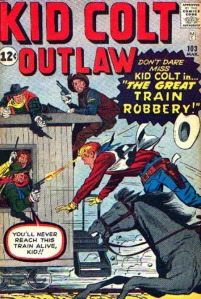
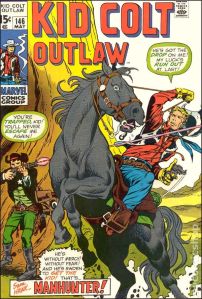


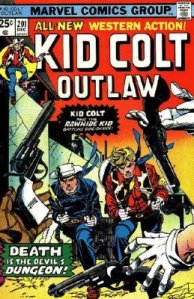
Angie Dickinson
Sunday Funnies – 02

Wyatt Earp Card Game
The Wyatt Earp Card game plays a lot like Rummy but with contextual modifiers that make the experience a fun western challenge. There are gunfights, and bank robberies, cash and rewards, but most of all there are well-known real life outlaws that have to be captured in order to come out as the numero uno lawman.
 It’s not the most complex of games, but it does require a bit of strategy. Players work both together and against each other in their efforts to accumulate the most reward money. You have to put together sets in order to get capture points, which allow you to eventually capture the bad-guys. Mixed in to the pile of draw cards are things like Hideout, Wanted, and most significantly, Wyatt Earp. These cards have special conditions allowing a player to do things like taking items from a rival, or drawing extra cards.
It’s not the most complex of games, but it does require a bit of strategy. Players work both together and against each other in their efforts to accumulate the most reward money. You have to put together sets in order to get capture points, which allow you to eventually capture the bad-guys. Mixed in to the pile of draw cards are things like Hideout, Wanted, and most significantly, Wyatt Earp. These cards have special conditions allowing a player to do things like taking items from a rival, or drawing extra cards.
No one player gets to be Wyatt Earp, instead he exists as a special card that can be drawn from the deck and allows you helpful maneuvers. But for the historical buffs, there are seven true-to-life outlaws for the players to arrest and capture. These miscreants are Belle Star, Jesse James, Billy the Kid, Bob Dalton, John Wesley Hardin, Butch Cassidy, and the Sundance Kid.
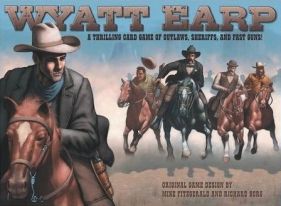
It’s an easy-to-play game that doesn’t take long to catch on to, so if you sit down to play for the first time, everyone should be on board and having fun in a relatively brief time. You can find it on EBay or Amazon, but there is something to know if you do go looking for it. The first version was released in 2001 by Rio Grand, but then it was re-released in 2014 by Eagle-Gryphon. This is important to know because the original release sells for quite a bit more and might discourage someone who was hoping to make the purchase. But the newer release is a more standard price at about twenty-five dollars, plus shipping, depending on who you order from.
Bat Masterson: The Man and the Legend
Bat Masterson: The Man and the Legend by Robert K. DeArment is one of only two primary biographies on the man; the first being by Richard O’Connor in 1957. DeArment offers approximately 130 pages over O’Connor, and gets more in depth to the details of Bat’s life. Including a pretty thorough portion on the drama of Bat and his writing career. In fact, I would think it’s safe to say that DeArments interest is more in the relational machinations of the man than his time as a frontier tough-guy.
The book is a fairly straightforward biography with a few little nuances to it. The author generally follows a straight timeline, but also does some chapter grouping by topic. This has its pluses and its minuses. On the positive, it help to paint a picture of given occurrences within whatever life-arena is being focused on, but on the flipside of that, there are occasions where the reader may need to cross check some of the items to make sure they’re tracking in the right time frame.
Some of the things I noticed in DeArments book is that he almost seems to consider Bat’s gun wielding as a bit of a bother. Perhaps my take is a bit more sensitive than the average reader, but I often got the impression that the author was very mindful to not give any undue attention to his exploits; almost working to retain a bit of dignity to this hardened killer.
Often times, and this is something I’ve never understood, some who study the old west do so with a bit of a look down their nose at their subjects. I wouldn’t say that DeArment goes this route, but there is a sense that his enthusiasm for his subject is not borne of Masterson’s frontier desperations, and somewhat leans more academic when talking about a man whose life was defined by his adventures on horse and with pistol.
The last note I would make on DeArments style is that he seems to have a dislike for Wyatt and therefore argues against certain claims regarding him as an aside in certain situations where the two are involved. The problem with this is that it creates a subtle vibe of Bat being better than Wyatt when such an offering or conclusion seems out of place.
To switch gears before it seems like I dislike the book, let me be clear that these are nuances in the book and not glaring problems. I also reiterate that my sensitivities may not be inline with the average reader, and may not stand out as they did to me. So please read for yourself. It really is a great book and quite thorough.
The primary value of this book is that you come away with a fairly complete picture of the man, and a great understanding of who he was and what he was probably like. So, in spite of my own previous words, DeArments varying emphases comes together to offer a well rounded look. From his early time on the frontier to his days in Dodge and Colorado as a dueling writer, and where he finally settled to his last days in New York City, this book covers it all.
A Brief Look at the Towns of the Old West
This post is intended as a preamble for the list of old west towns.
There were a few main types of towns that prospered in the old west. As with most everything in this world, there is a process of building to something, and then there’s the path leading away from that particular moment in time. Towns in the western frontier were unique because they served a point in time that was unique, and just as everything else, there was a reason they were built and a reason that they went the way they did; whatever that direction may have been.
The most commonly thought of towns in the old west were Cow-Towns and Boom-Towns. It’s true that a cow-town could also be a boom-town, but most often they were essentially separate in their proliferations. In addition to these two types we had trail towns and supply towns. A supply town may not be a boom-town/mining camp, but due to it’s proximity, along with helpful attributes, such as being aligned with a well used trail road, the supply town could see prosperity in a symbiotic relationship to the boom-town/mining camp.
One very common locale in the old frontier days that won’t be included were the military forts. Because it is such an in depth element all of it’s own, and the fact that they were military fortifications, not the places of bar-fights and shootouts, we won’t be including it. However, in a dynamic mimicking the coupling of supply town to mining camps, likewise camp-towns often accompanied the military forts of the west.
Very often a town would spring to life along a commonly used trail. At first it may be nothing more than a trading post, then perhaps the addition of another establishment leads it into becoming a small trail town. Then one day the train makes a stop and now it becomes known for foot traffic arriving by rail, and commonly becomes identified as a train stop town. One interesting case in this is El Paso, Texas. The community existed for some time do to it’s crossing from Jaurez, Mexico. It eventually became a prominent travel hub, being setup as a primary route for those traveling to and from Texas to New Mexico, Arizona, or Colorado. Yet despite the fact that it was such a center-piece for western travel, it didn’t enjoy the trains arrival until May of 1881, where Marshal Dallas Stoudenmire was present to greet the president of the rail company.
For the sake of a bit of easy clarity, I have distinguished between a cow-town and a cattle town. The cow-town being one that prospered from the arrival of the cow-boys and their cows from Texas (or other locations), and the cattle town being a place that prospered from the sale of cattle. For illustrations sake, San Antonio might be considered a cattle town due to the ranchers who owned and sold cattle en mass, and Dodge City, where the cow-boys drove this cattle and wildly celebrated at the end of the drive, would be referred to as a cow-town.
None of these descriptors are encyclopedic presets, they are merely what I have decided on for my own simplified reference points. There were, of course, other types of towns, such as agriculture communities and others, but since these were very seldom locations that drew the gun-toting element, they are very rarely ever mentioned. An example of this could be Phoenix Arizona, which was planned and plotted along the Gila River for agriculture. With it’s differing origins and purposes from Tucson, Prescott, or Tombstone, it’s not one that’s really ever heard of in the annals of the wild west. (As a side note to Phoenix, if you would like a glimpse at the history of Phoenix from the old days, the only remaining building in the original downtown area stands at 2nd & Washington and serves, presently, as a sports bar/night club.) Wichita started out also as an agricultural community, but once the cattle trade started driving there, it became, primarily, a cow-town. This lasted until the cattle industry ventures migrated elsewhere; which brings around another key factor in the life of western towns.
Very few old west towns went on to prominence. Dodge City has maintained, but never became huge. Phoenix became huge, but was never really an old west stomping ground. Denver could be a rare case where a traditional fighting, gambling, whoring community made good and is still impactful today. But with most of these towns there was a trend that was common. First a community would struggle to attract commerce, then, subsequent efforts to attract people would often bring about a rowdy crowd. These were often the cow-boys, the lawmen, the gamblers, rustlers, and everybody in general who saw a chance to make some money. But these classes of citizens were not the desired bedrock of the community and once a town had attracted what it wanted, it began to filter out what it didn’t. This led to the removal or exiting of many of the colorful western element, and left the towns to go their own course.
Today, we, the historically enthused, chase around after these sacred locales, studying and absorbing what they were and what they are. To get a broad snapshot of what the towns were and a few pertinent details, please refer to the Old West Towns List. You can simply look up a town by name, or scroll through the list. The intent is to give a quick, easy idea of what things looked like. You can look at the census for Deadwood and see how it grew, or compare it to Ogallala and others to get an idea of what the town might have looked like at a time when a certain hombre strolled in. Hopefully with a little context and juxtaposition, a better understanding can be had.
Sunday Funnies – 01


